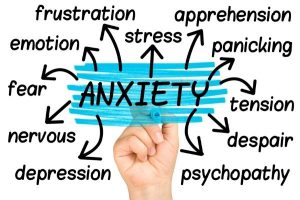I was 5 years old when I experienced my first panic attack. I didn’t have a word for it, but looking back, I know exactly what it was. From then on, I have experienced many, and they have ranged from inconvenient to completely debilitating. My anxiety has stolen a lot from me over the years—sleepovers, trips, school, sports, and even friends. It has told me I wasn’t good enough, that nobody liked me, and I wouldn’t ever be successful.
 When I was 23 years old, I decided to start seeing a therapist. Almost immediately, I was diagnosed with anxiety and depression. Finally, I had a name for the feelings I had always felt, and soon I had tools to help combat those negative feelings. Healing is hard work, but I took the first step. My therapist has helped me navigate the loss of family members, coming out, marriage, a baby, and countless flares of anxiety and depression.
When I was 23 years old, I decided to start seeing a therapist. Almost immediately, I was diagnosed with anxiety and depression. Finally, I had a name for the feelings I had always felt, and soon I had tools to help combat those negative feelings. Healing is hard work, but I took the first step. My therapist has helped me navigate the loss of family members, coming out, marriage, a baby, and countless flares of anxiety and depression.
In 2019, I was at my wit’s end. I couldn’t get out of bed, and it was debilitating. My anxiety and depression were no longer well managed, and I did not know what to do. Once again, I turned to my therapist for help. Together, we made a plan. I was lucky enough to be able to have time away from work to focus solely on my mental health—something I know is a luxury for most people. I started in group therapy three times a week and continued individual therapy. I also worked closely with my psychiatrist to make necessary changes to my medication. Over the course of two months, I got worse. As it turns out, group therapy was incredibly draining for me, and I just absorbed everyone else’s trauma. We needed to pivot.
Upon the advice of my individual therapist, my group therapist, and my psychiatrist, I started researching Transcranial Magnetic Stimulation (TMS). I had never heard of it, and I certainly did not know anyone who had done it. Honestly, it all sounded a bit intense. I got the ball rolling with my insurance carrier to see if it was even going to be an option for me. Once it was approved, I decided to go for it. After all, I didn’t have much to lose.
TMS works by stimulating the nerve cells in your brain. Think of it as politely asking those lazy nerve cells to get back to work in relieving my depression symptoms. The treatment itself is painless but a bit uncomfortable at first. It is also a time commitment. Treatments vary based on individual needs, but for me it was 35 sessions (Monday-Friday for seven weeks), each session lasting 36 minutes.
When I first started, it made me sleepy. I couldn’t stay awake all day and had to take frequent naps. After a couple weeks, I started feeling better, even noticing that some of my depression symptoms had improved. About halfway through, many patients experience what is called a “dip”—symptoms may get worse. For me, this was temporary. I saw a huge relief of symptoms and was in remission at the end of treatment. Though anxiety and depression will always be a part of my life, my treatment goal was to alleviate some symptoms and get back to a normal life.
Three months after I finished TMS, the pandemic started and my anxiety and depression were noticeably absent. It was actually alarming how not panicked I was. Because of TMS and the hours of therapy, my outlook was positive and my mood was just short of chipper. I felt prepared to take on the challenge of a pandemic and even excited to spend extra time with my wife and kid. As time went on, the state of the world slowly chipped away at the peace I had just recently found. Monthly therapy sessions turned into every other week which turned into every week. I quickly found myself back to where I was not long before. I was scared and panicked, but this time I knew better.
 My therapist, god love her, had seen this coming, and again, we made a plan. We decided against group therapy since it proved unsuccessful before. Once again, my psychiatrist adjusted my medication. We gave it time to work. Individual therapy sessions increased. This time, I didn’t get worse, but I wasn’t improving—at least not at the rate I wanted to. So this past March, I started TMS again. The last thing I wanted to do was admit I couldn’t manage my anxiety on my own, but once I surrendered, things got easier. While I am currently still in the middle of my second round of TMS, I have hope. I have hope that since this worked before, it will work again. I have hope that my next season of remission will last longer. I have hope—which is something I lacked.
My therapist, god love her, had seen this coming, and again, we made a plan. We decided against group therapy since it proved unsuccessful before. Once again, my psychiatrist adjusted my medication. We gave it time to work. Individual therapy sessions increased. This time, I didn’t get worse, but I wasn’t improving—at least not at the rate I wanted to. So this past March, I started TMS again. The last thing I wanted to do was admit I couldn’t manage my anxiety on my own, but once I surrendered, things got easier. While I am currently still in the middle of my second round of TMS, I have hope. I have hope that since this worked before, it will work again. I have hope that my next season of remission will last longer. I have hope—which is something I lacked.
TMS is certainly not for everyone and to even say I am unqualified to recommend a medical treatment is an understatement, but my point (I swear I have one) is that there is something out there to help. If you can’t find help, ask for it. Ask your friends, your family, your doctors. Ask me—a random stranger on the internet. Do not be afraid, do not be ashamed. Be relentless. I promise you it gets better, but you do have to fight for it.
















